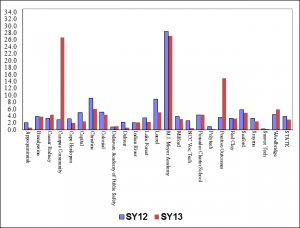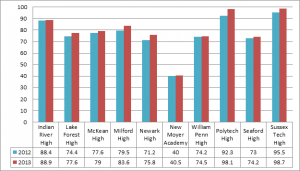The state’s latest high school dropout report, released today, shows a 30-year low in the percentage of students leaving high school before graduation.
The annual Delaware Department of Education report, presented to the State Board of Education at its monthly meeting today, shows 1,106 of the 38,613 students enrolled in grades 9 to 12 dropped out of school in 2012-13, a rate of 2.9 percent. That is a 1-point decrease from the previous year’s rate of 3.9 percent.
“Educators across our state have been working hard to better identify students at risk and provide the intervention and supports that these children need to ensure they stay in school earlier,” Secretary of Education Mark Murphy said.
“We can celebrate this progress because of their commitment to their students. At the same time, we know challenges remain,” he said. “A high school diploma is essential to a child’s success. We must continue to work to reach those still leaving us before they have completed their education.”
Governor Jack Markell also praised educators for their hard work.
“This trend is a tribute to the innovative and determined work by everyone in our education system to ensure that all of our young people have the best chance to succeed,” Markell said. “It follows recent evidence showing that fewer of our students are falling behind as freshmen, which is a critical indicator of whether they will graduate on time. We still have a lot of work to do, but these improvements should energize our efforts to ensure every student not only graduates high school, but does so ready to pursue college or a career.”
While the state collects data from all public schools including grades 7 to 12, the annual dropout rate is calculated from grades 9 to 12, as prescribed by the National Center for Educational Statistics (NCES), which provides data to the federal reporting system. Data also is collected from private schools and families who homeschool their children. That information is only used to verify whether students transferred from public to private and home schools.
The annual dropout rate, developed by the U.S. Department of Education, is calculated by dividing the number of students who drop out over a one-year period by the October 1 grade 9–12 enrollment, multiplied by 100. Dropouts are those students who dropped out of school between July 1 and June 30 of a given year and did not return to school, graduate, or receive a GED by the following October 1.
The state report (attached) provides analysis based on demographics and geographic breakdowns, including by county and districts/charter schools. For 2012-13, New Castle County had the highest percentage of dropouts (3 percent) followed by Kent (2.9 percent) and Sussex (2.4 percent). Statewide, 44.8 percent of those students who dropped out were black, followed by 42.5 percent white and 12.7 percent Hispanic.

The state also released annual graduation rates today. The graduation rate tracks a cohort of students from 9th grade through high school and represents the percentage of the cohort that graduates within a certain amount of time. This measurement also saw progress with a statewide rate of 79.9 percent, up slightly from 79.6 percent the year prior.
While the annual dropout rate provides information about one particular school year and all students enrolled in high school in that year, the graduation rate provides information about a particular group of students followed over the course of high school. It looks at all students who started high school at the 9th grade and how many graduated within four years. For this year’s data, that means students who started 9th grade in the 2009/10 school year.
Schools with Increases in Graduation Rate in 2012-13

Supported by local, state and federal Race to the Top funds, districts and schools across the state have implemented local programs to meet their students’ needs.
Superintendent Dr. Freeman Williams credited Christina’s progress to the multiple strategies the district has undertaken. The district saw a dropout rate of 6.1 percent in 2012-13, down from 9.1 percent in 2011-12.
“Beginning last school year, key administrative staff in Christina met monthly with graduation guides, visiting teachers, guidance counselors and staff from our adult and continuing education programs. They centered their monthly meetings on dropout prevention and had robust conversations that helped to frame a systemic approach to decreasing our dropout rate,” Williams said.
Their strategies focused on several key areas, he said: increased awareness of record keeping issues; increased collaboration across schools; increased collaboration among student support personnel (guidance counselors, visiting teachers and graduation guides); adjustments to the district’s service delivery model as it pertains to credit recovery; increased technical and student data assistance for building-level leaders to identify and track progress of students at risk; increased awareness of options available to students who have high risk indicators for dropping out; and expanded partnerships with internal and external resources.
In the Capital School District, Dover High Principal Evelyn Edney also credited its progress – the dropout rate of 2.4 percent is a decrease from the previous year’s 4.9 percent — to multiple strategies that focus on at-risk students. The district’s graduation rate also went from 74.1 to 80.3 percent.
“We are really trying to track the students. Our counseling team has been instrumental in helping to review the data with the administrative team and help to track the students’ progress in classes to indicate interventions that need to be put in place to help the student to become more successful,” she said.
Interventions include extra help sessions with teachers, referral to the 21st Century After School Senator Success Program, double courses in English language arts and mathematics and the creation of a Daylight Program to complement Dover High’s existing Twilight Program. The Daylight and Twilight programs, which primarily support students at-risk for not graduating with their peers, provide a credit recovery avenue. All courses are taken online, and a teacher supports the students in the programs through academic assistance, promoting responsible decision-making and coping skills and building self-discipline.
In the Appoquinimink School District, credit recovery programs also have been key to helping students keep from dropping out. The district’s rate went from 2.1 percent in 2011-12 to 0.7 in 2012-13.
“It starts by monitoring the data, so we know who the kids are that are at-risk of dropping out,” Middletown High Assistant Principal Voni Perrine said. “Once we identify a student, they receive a high level of attention from a team of staff members.”
Middletown’s Twilight program is “a self-paced, computer-based program that’s supported by teaching staff. Students move quickly through concepts they understand and spend as much time as they need in areas where they are weaker. When they’re ready, they can rejoin their classmates and graduate on time – which is an important feature of the program,” Perrine said.
The district also offers students the option to take classes with the Groves Adult Education Program. The evening courses there can supplement their daily schedule.
“The goal is to help students who have fallen behind realize that they can make up for lost time and graduate with their peers,” Perrine said.
Parents also are key partners, she said: “We meet with the family to establish a relationship, identify the challenges the teen is facing, and help that young person set goals to get back on track. Students meet with members of the team on a regular basis to review their coursework, celebrate progress, identify challenges and maintain a positive focus on long-range goals and objectives.”





